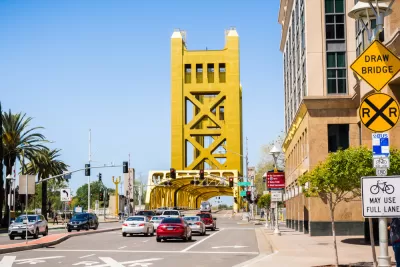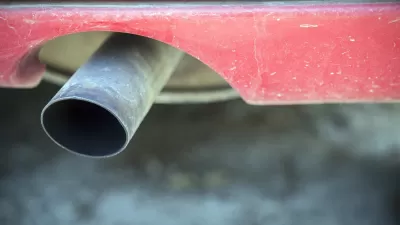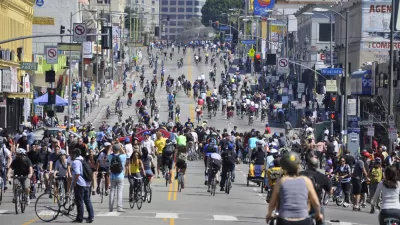As California tries to stem its increasing greenhouse gas emissions from the transportation sector, its capital, Sacramento, may prove to be a model for other cities as it embraces electric vehicles and strategies to reduce driving.

California received an "A" in its greenhouse gas (GHG) emissions report card issued in July, notwithstanding a two percent increase in emissions from the transportation sector, growing to 41 percent of the GHG Inventory pie. "Private, passenger vehicles account for a full 28 percent—the largest single chunk—of California’s greenhouse gas emissions," writes Alissa Walker, urbanism editor at Curbed.
“People don’t understand the impact of the personal car,” says Lezlie Kimura Szeto, manager of the California Air Resources Board (CARB) sustainable communities group.
Szeto's group is the outgrowth of a 2008 law authored by state Sen. Darrell Steinberg, Senate Bill 375: The Sustainable Communities and Climate Protection Act, a successor to the state's landmark climate Global Warming Solutions Act of 2006 (AB 32) which didn't deal with the land use aspect of mitigating climate change.
Steinberg was elected mayor of Sacramento in 2016, providing him "a unique opportunity to enact sustainable infill policies he championed in the California Legislature," posted Planetizen contributor Ross Zelen.
"If we’re going to meet our climate change goals, we have to build our communities to allow people to not be in their cars for so long—and certainly not in a single-occupancy car,” Steinberg tells Walker.
A central part of reaching those climate goals, now "40 percent below 1990 levels by 2030 under SB 32" after the AB 32 goal for 2020 was accomplished four years early, will be decarbonizing transportation via electrification. As Planetizen contributor, Elana Eden, posted last November, Sacramento is a designated "Green City" by Volkswagen subsidiary Electrify America, allowing it to receive $44 million "to increase electric vehicle use through a variety of programs, including infrastructure installation, outreach, and accessibility measures."
One of those programs was included in a recent comprehensive article (via Planetizen, Oct. 17) by Rebecca Bellan of CityLab about the progress that electric vehicle (EV) adoption is seeing locally (but experiencing setbacks nationally due to Trump administration): "Two all-electric car-share companies, GIG Car Share and Envoy Technologies, are working to launch their services in Sacramento funded by a unique Electrify America grant..."
Demographics
"The city hopes to have 35 percent of the city’s households use EVs, but currently, whether or not a household uses an electric vehicle is largely determined by income," adds Walker. “Right now, the biggest indicator is wealth,” says Jennifer Venema, Sacramento’s sustainability manager for its Department of Public Works. “We want to flip that to make it about access.”
Through a community-based partnership, the city found that lower-income neighborhoods even further from the city’s downtown are home to families with the highest rates of car ownership. And because they are forced to drive more, these families end up paying for and shuffling between multiple cars due to reliability issues.
“So here we have high numbers of cars per family fulfilling low-density needs,” says Venema. “We need to make sure the [on-demand microtransit shuttle (which will soon be electric, thanks to Electrify America)] service delivers for these households.”
Not by electrification alone
While Walker's deep dive into reducing auto-dependency is centered on Sacramento, she tackles the issue more broadly, due in part to the importance of SB 375, including its shortcomings. [See final paragraph of this post.]
“There is a persistent belief, among both state officials and the public, that clean cars and clean fuels alone can achieve California’s climate goals, but this is fundamentally untrue,” says Matthew Baker, policy director for the Planning and Conservation League. “Even if we have 100 percent zero-emission vehicles and 75 percent renewable energy production by 2050—both ambitious goals—we still need a 15 percent reduction of VMT beyond what current regional plans project to achieve." [Note: SB 100 now calls for 100 percent carbon-free electricity by 2045].
Plus EVs are not a public health panacea. “EVs don’t relieve congestion, and the dust from brakes and tires are a major source of particulate matter air pollution, which causes respiratory illness,” says Bryn Lindblad, associate director of Climate Resolve. “That last fact doesn’t really seem to be on people’s radar as they look to EVs to be the solution.”
“Every new freeway lane locks us into decades of more pollution,” says Carter Rubin, a mobility and climate advocate at the Natural Resources Defense Council. “To get to carbon neutrality, we need to shift from encouraging driving, to investing in walking, biking, public transit, and shared electric vehicles.”
Detour to Davis
Fortunately, Walker chose to take a 14-minute Amtrak train ride on the bike-friendly Capitol Corridor to Davis.
In most California cities, the percentages of trips taken by walking, biking, and transit are currently single digits—except for one city famous for achieving what much of the state has not been able to do.
A League of American Bicyclists' study [pdf] found that Davis had the nation's highest bike commuting rate in 2016 – 16.6 percent, though other studies report 20 percent. The college town, home to the University of California, had a bike-friendly reputation dating to the 1950s, according to Access Magazine, but the transformation occurred through many policy shifts since then.
"In 1967, a group of local politicians worked to get the state law changed so bikes could officially share space with cars on streets, resulting in the first protected bike lane in the U.S.," notes Walker.
The future
California did not invent the car, notes University of California at Davis professor Daniel Sperling, also a CARB board member, but it invented car-centric cities. Now the state can serve as a good example of how to repair this damage, said Matthew Rodriguez, secretary of California’s Environmental Protection Agency. “If California can do this, it’s something other places can learn from because people are so mindful of our car culture.”
Revisiting the 2008 sustainable communities law, SB 375, should be on top of the agenda for state policymakers. "[T]he law’s impact is limited by insufficient incentives and enforcement mechanisms," write Sarah Mawhorter and Carol Galante of the Terner Center for Housing Innovation at UC Berkeley as an introduction to an analysis released in July on the 10-year old legislation.
On its own, and without increased funding and facilitation, SB 375 cannot sufficiently impact development patterns to meaningfully meet California’s urgent affordable housing and sustainability needs.
Related in Planetizen:
-
Sacramento Mayor Darrell Steinberg hopes that an infusion of EV funds can jumpstart a new, clean economy in the city.
-
Sacramento Rising: Mayor-Elect Darrell Steinberg's Vision for Sustainable Communities, August 26, 2016Mayor-Elect Steinberg enters City Hall as a leader with a unique opportunity to enact sustainable infill policies he championed in the California Legislature.
Hat tip to Steve Birdlebough.
FULL STORY: When electric isn’t good enough

Alabama: Trump Terminates Settlements for Black Communities Harmed By Raw Sewage
Trump deemed the landmark civil rights agreement “illegal DEI and environmental justice policy.”

Study: Maui’s Plan to Convert Vacation Rentals to Long-Term Housing Could Cause Nearly $1 Billion Economic Loss
The plan would reduce visitor accommodation by 25% resulting in 1,900 jobs lost.

Planetizen Federal Action Tracker
A weekly monitor of how Trump’s orders and actions are impacting planners and planning in America.

Wind Energy on the Rise Despite Federal Policy Reversal
The Trump administration is revoking federal support for renewable energy, but demand for new projects continues unabated.

Passengers Flock to Caltrain After Electrification
The new electric trains are running faster and more reliably, leading to strong ridership growth on the Bay Area rail system.

Texas Churches Rally Behind ‘Yes in God’s Back Yard’ Legislation
Religious leaders want the state to reduce zoning regulations to streamline leasing church-owned land to housing developers.
Urban Design for Planners 1: Software Tools
This six-course series explores essential urban design concepts using open source software and equips planners with the tools they need to participate fully in the urban design process.
Planning for Universal Design
Learn the tools for implementing Universal Design in planning regulations.
Caltrans
Smith Gee Studio
Institute for Housing and Urban Development Studies (IHS)
City of Grandview
Harvard GSD Executive Education
Toledo-Lucas County Plan Commissions
Salt Lake City
NYU Wagner Graduate School of Public Service





























